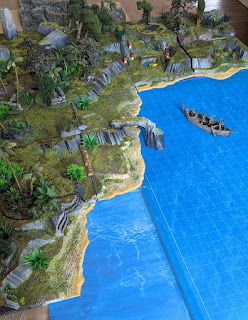Whether you often play via VTT and suddenly have the opportunity to run a tabletop game, or simply have a colorful and interesting map that you want to bring to your tabletop game, here are a few tips for making it work, with very little time and almost no cost.
All you need is a color inkjet printer, some paper, scissors and scotch tape.
Last spring, I needed a cool warehouse map for my players to invade to stop some nasty slavers and free their victims. I made this map on Dungeondraft (with Forgotten Adventures assets), including the ground floor, and upper-level catwalk around the edges, and a below-ground water-filled area for smugglers' boats to make deliveries and pickups. Here are the maps.
I wanted to print out this map using 1" squares for 28mm figures. I did it using Word, and this simple procedure:
1) Paste the whole image onto a blank work document, with narrow margins.
2) Using the crop tool, cut down the image to the upper left corner, remembering that a standard sheet of paper can display roughly 8 x 11 1-inch squares.
3) After cropping the image, increase the size to fill the page.
4) Now the cool part: copy & paste the image (Ctrl+C, Ctrl+V) into a new line following the original image, then without changing the size at all re-crop the image so that it shows the next section. As long as you only use the crop tool and don't re-size the image, you'll be able to line up the sections perfectly.
5) Repeat this procedure until you have the entire image reproduced in 1-inch squares. I needed 12 pages for the ground floor of this warehouse.6) Print it all, then cut off the right and bottom white margins from each page except for the right-most page where you only cut the bottom, and the bottom-most row where you only cut one side. That way, you will have some overlap, allowing you to more easily tape the pieces together. Tape the pieces carefully so they line up exactly and lie flat.
7) I wanted to be able to display the upper-level catwalks and office next to the map, so those pieces needed to be more mobile and more sturdy. So I glued sections onto semi-rigid foamcore, cut to the right dimensions. This turned out to be an even better plan, since the game story (Past Present Future Comics in West Palm Beach) had piles of Warhammer ruins that I was able to borrow to represent the corners of the warehouse and prop up my sections of catwalk. If I'd had more time, I would have made my own walls and corners out of foamcore, but this turned out to be a lot quicker and easier.
This method works with maps you make yourself or that you can find on the Internet. Quick tip: do a Google image search for "battle map keyword" where the keyword is "warehouse", "castle", "ruins" or whatever. Alternatively, if you have the pdf of an adventure from Paizo or some other publisher, you can probably select a map, Ctrl+C and Ctrl+V into any image processing software (even MS Paint) to grab the base image for use at your table. This is what I did for a ruined castle I needed for a different sequence of the campaign. Here, you can see parts of the map are covered over, to keep the interiors secret from the players. A better effect would have been to prepare sections of cardboard sized for each building or group of rooms. But hey, each time you do something like this, you learn what works and can do better the next time.
Total cost: some ink and paper for the printer (hard to quantify), perhaps a sheet of foamcore or simply cast-off cardboard.
Last tip: storing the maps works best when they are rolled (image side out!) rather than folded, as the taped joints can fold badly.



























